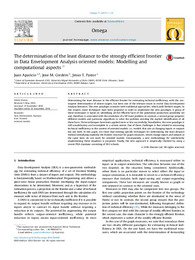Título :
The determination of the least distance to the strongly efficient frontier Data Envelopment Analysis oriented models: Modelling and computational aspects |
Autor :
Aparicio Baeza, Juan
Cordero, Jose M.
Pastor Ciurana, Jesús Tadeo |
Departamento:
Departamentos de la UMH::Estadística, Matemáticas e Informática |
Fecha de publicación:
2016-09-23 |
URI :
http://hdl.handle.net/11000/4926 |
Resumen :
Determining the least distance to the efficient frontier for estimating technical inefficiency, with the consequent determination of closest targets, has been one of the relevant issues in recent Data Envelopment Analysis literature. This new paradigm contrasts with traditional approaches, which yield furthest targets. In this respect, some techniques have been proposed in order to implement the new paradigm. A group of these techniques is based on identifying all the efficient faces of the polyhedral production possibility set and, therefore, is associated with the resolution of a NP-hard problem. In contrast, a second group proposes different models and particular algorithms to solve the problem avoiding the explicit identification of all these faces. These techniques have been applied more or less successfully. Nonetheless, the new paradigm is still unsatisfactory and incomplete to a certain extent. One of these challenges is that related to measuring technical inefficiency in the context of oriented models, i.e., models that aim at changing inputs or outputs but not both. In this paper, we show that existing specific techniques for determining the least distance without identifying explicitly the frontier structure for graph measures, which change inputs and outputs at the same time, do not work for oriented models. Consequently, a new methodology for satisfactorily implementing these situations is proposed. Finally, the new approach is empirically checked by using a recent PISA database consisting of 902 schools
|
Palabras clave/Materias:
Data Envelopment Analysis
least distance
oriented models |
Área de conocimiento :
Análisis |
Tipo documento :
application/pdf |
Derechos de acceso:
info:eu-repo/semantics/openAccess |
DOI :
https://doi.org/10.1016/j.omega.2016.09.008 |
Aparece en las colecciones:
Artículos Estadística, Matemáticas e Informática
|
 La licencia se describe como: Atribución-NonComercial-NoDerivada 4.0 Internacional.
La licencia se describe como: Atribución-NonComercial-NoDerivada 4.0 Internacional.
.png)
